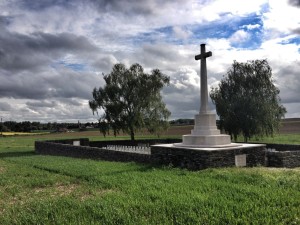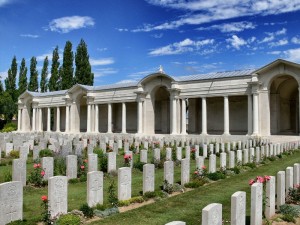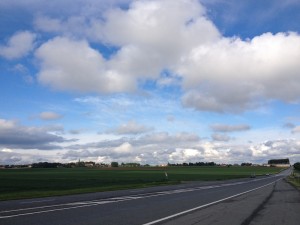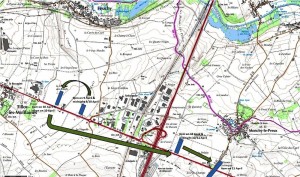Posts Tagged ‘Second Battle of the Scarpe’
Following the 10th Battalion Loyal North Lancashire Regiment around Arras
I recently led a one day trip to the Arras battlefields for three generations of a soldier’s family (nephew, great-nephew and great-great nephew). I had been asked to research the actions of Private Horace Pantling, 10th Battalion Loyal North Lancashire Regiment around Arras. Horace’s Battalion formed part of 112th Brigade, 37th Division and will be forever known with the actions on 11 April around the small hilltop village of Monchy-le-Preux.
After a general briefing on the battle and a visit to the Carrière Wellington to take a tour around the underground system we headed out on the battlefield, starting on the British front line on 9 April 1917, the first day of battle. Following the arrow straight Arras-Cambrai road I explained the attack British assault up to the Brown Line near Feuchy Chapel. From then I was able to use a series of maps from the 37th Division files that showed positions of units every three hours for the first three days of battle. We followed the 10th Loyal North Lancs in their advance up the road in the early morning of 11 April. With the neighbouring 111th Brigade attacking the village of Monchy it was down to the 112th Brigade to take the Green Line to their right.
The Battalion war diary records that on moving to their assembly positions for the 5.30am advance the 10th Loyal North Lancs immediately were ‘met with very heavy Machine Gun and Shell fire’. However, their assault on the trenches around the La Bergère crossroads was successful and positions were consolidated. Casualties were estimated at 13 Officers and 286 men for the Battalion’s part in the opening stages of the Arras offensive. A number of the Battalion’s dead now lie in the nearby Tank Cemetery.

Tank Cemetery, Guemappe where many men of the 10th Loyal North Lancs killed on 11 April 1917 now lie
As we looked over the gently rising fields near Monchy it was hard to imagine the scene in the early morning of 11 April 1917. We had been blessed with a clear, spring day. The British troops who performed so magnificently that day 96 years ago did so with heavy snow and a chill wind across the battlefield.
Having been taken out of the line for a rest they were next in action on 23 April during the 37th Division’s assault on Greenland Hill during the Second Battle of the Scarpe. The war diary made grim reading with very little gain possible owing to the German occupation of the Chemical Works at Roeux on the right. On the 27th orders were received to attack Greenland Hill at dawn the next day. At 4.27am on 28 April that Battalion attacked and reached a trench that had been begun by the enemy. The war diary records that ‘By this time the Battalion had suffered heavily and only one officer was left’. Once more suffering from enfilade fire from the Chemical Works, the Battalion dug in. The attack was yet another failure in the face of superb German resistance.

28 April 1917 map of Greenland Hill overlaid on to Google Earth. Map taken from 37th Division War Diary, National Archives Ref: WO95/2513
It was during the actions on the 28th that Horace Pantling was killed. Horace, like so many British killed in the latter stages of the Arras offensive, has no known grave and is commemorated on the Arras Memorial. We were able to stand close to the positions where the 10th Loyal North Lancs assaulted and then, after a circuitous journey walk close to the spot where the Battalion dug in. It is one of those strange twists of fate that the junction of the A1 and A26 motorways now stands slap-bang right on Greenland Hill. Only by heading toward Plouvain and turning down a narrow track could we get close to the spot where the Battalion ended up. Sadly, the exact spot is now accessible only by driving on the slip road from the A1 to join the A26.

Arras Memorial where Horace Pantling and a further 35,000 servicemen from the United Kingdom, South Africa and New Zealand who died in the Arras sector between the spring of 1916 and 7 August 1918 are commemorated
We had visited Horace’s name on the Arras Memorial earlier in the day so it seemed a suitable place to end the tour. What struck me, as ever, was the small distances – easily covered in a minute or two in the car – that took so much effort to capture and consolidate in spring 1917. The British casualty figures for the Battle of Arras make sobering reading; 159,000 casualties in 39 days – averaging 4000 casualties per day. Despite countless visits to the battlefields such scale of loss in concentrated areas still both appals and moves me. Horace Pantling was one of those casualties but his name is certainly not forgotten and three generations of his family now know the ground over which he fought and was ultimately killed in April 1917.
“Thank you so much for organising such an excellent day in and around Arras last week. We all hugely enjoyed having your professionalism, enthusiasm and knowledge on tap, and your organisation was faultless! My father came away thrilled with the trip, and that was all I could have asked.” Nigel Pantling
A superb resource for those interested in the 10th Loyal North Lancs is Paul McCormick’s website http://www.loyalregiment.com/.


